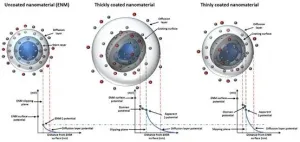Monarchs raised in captivity can orient themselves for migration, U of G study reveals
While captive rearing may cause temporary disorientation, researchers found if Monarchs are given time in the wild to calibrate their internal compasses they can fly in the proper direction
2021-06-08
(Press-News.org) Monarch butterflies raised indoors still know how to fly south if given enough time to orient themselves, according to new University of Guelph research.
The finding is good news for the many nature lovers and school students who raise monarchs and then set them free to help boost struggling numbers.
Monarchs are the only butterfly known to make a long-distance migration to warmer wintering grounds. While those born in the spring and early summer live only from two to six weeks, those that emerge in the late summer sense environmental signals that tell them to fly thousands of kilometres south, to central Mexico.
Recent U.S. studies have suggested that captive-raised monarchs become disoriented when they emerge from their cocoons and cannot fly south. But this new research, led by U of G PhD student Alana Wilcox and integrative biology professor Dr. Ryan Norris, finds that may not be true.
Wilcox said previous research was conducted only in a "flight simulator," involving placing the butterflies into an open vessel and then gauging which direction they try to fly. The U of G team used a flight simulator but also tracked a second group of monarchs that were released in the wild after being equipped with tiny radio transmitters.
Those butterflies showed proper southward orientation, if given enough time to get their bearings.
"We believe the reason why the monarchs released in the wild flew in the proper direction is likely because they had time to calibrate their internal compasses after being released, which ensured they flew in a southerly direction," said Norris.
The new study appears in the journal Conservation Physiology. Integrative biology professor Dr. Amy Newman and Dr. Nigel Raine, a professor in U of G's School of Environmental Sciences, contributed to the research.
The team came upon the finding almost by accident. They had been investigating whether monarch caterpillars raised on milkweed grown in soil with a neonicotinoid pesticide would have trouble migrating once they moulted into butterflies.
They found the pesticide did not appear to affect the butterflies' migration. But they noticed differences between the monarchs tested in the flight simulator and those that had been raised in the same conditions and released in the wild with radio transmitters.
Only 26 per cent of monarchs tested in the flight simulator (10 of 39 butterflies) showed a weak southward orientation after several minutes of testing; the rest flew in all directions. But almost all the radio-tracked butterflies (28 of 29, or 97 per cent) flew in a south-to-southeast direction from the release site and were detected at distances of up to 200 kilometres away.
"Our results suggest that although captive rearing of monarch butterflies may cause temporary disorientation for monarchs, once butterflies have been exposed to sunlight and natural skylight cues, they can establish proper orientation using their sense of proper flight direction," Wilcox said.
This process of orientation after release from captivity can take between 24 and 48 hours, added Norris.
The findings are good news for the thousands of butterfly enthusiasts and educators concerned that raising endangered monarchs in captivity might hamper their instinct to fly to their wintering grounds in Mexico.
The team notes the findings apply only to late-summer monarchs, which perceive environmental cues such as shorter days as signs that it's time to migrate to Mexico.
"Though the environmental conditions in our experiment might differ for monarchs reared by hobbyists, our results suggest that captive rearing remains a valuable educational tool for highlighting the natural history and biology of butterflies," said Norris.
INFORMATION:
Contact:
Dr. Ryan Norris
rnorris@uoguelph.ca
[Attachments] See images for this press release:

ELSE PRESS RELEASES FROM THIS DATE:
2021-06-08
Ever since the world's first ever microscope was invented in 1590 by Hans and Zacharias Janssen --a Dutch father and son-- our curiosity for what goes on at the tiniest scales has led to development of increasingly powerful devices. Fast forward to 2021, we not only have optical microscopy methods that allow us to see tiny particles in higher resolution than ever before, we also have non-optical techniques, such as scanning force microscopes, with which researchers can construct detailed maps of a range of physical and chemical properties. IBEC's Nanoscale bioelectrical characterization group, led by UB Professor Gabriel Gomila, in collaboration with members of the IBEC's Nanoscopy for nanomedicine group, have been ...
2021-06-08
Age-related macular degeneration (AMD) is the most common cause of vision loss in people over 50. Up to 12 percent of those over 80 have the chronic disease. An estimated 16.4 million adults are affected by retinal vein occlusion (RVO) worldwide, a condition caused by a thrombosis of a retinal vein. It is the second most common cause of blindness from retinal vascular disease after diabetic retinopathy (DR). DR in turn is the leading cause of blindness in developed countries and affects up to 80 percent of people with more than 20 years of diabetes. It can lead ...
2021-06-08
A defining characteristic of all life is its ability to evolve. However, the fact that biologically engineered systems will evolve when used has, to date, mostly been ignored. This has resulted in biotechnologies with a limited functional shelf-life that fail to make use of the powerful evolutionary capabilities inherent to all biology.
Sim Castle, first author of the research, published in Nature Communications, and a PhD student in the School of Biological Sciences at Bristol, explained the motivation for the work: "The thing that has always fascinated me about biology is that it changes, it is chaotic, it adapts, it evolves. Bioengineers therefore do not just design static artefacts - they design living populations that ...
2021-06-08
The presence of amino acids on the prebiotic Earth is widely accepted, either coming from endogenous chemical processes or being delivered by extraterrestrial material. On the other hand, plausibly prebiotic pathways to peptides often rely on different aqueous approaches where condensation of amino acids is thermodynamically unfavorable. Now, chemists from the Ruđer Bošković Institute (RBI), in collaboration with colleagues from Xellia Pharmaceuticals, have shown that solid-state mechanochemical activation of glycine and alanine in combination with mineral surfaces leads to the formation of peptides. ...
2021-06-08
A team of astronomers using the Atacama Large Millimeter/submillimeter Array (ALMA) has completed the first census of molecular clouds in the nearby Universe, revealing that contrary to previous scientific opinion, these stellar nurseries do not all look and act the same. In fact, they're as diverse as the people, homes, neighborhoods, and regions that make up our own world.
Stars are formed out of clouds of dust and gas called molecular clouds, or stellar nurseries. Each stellar nursery in the Universe can form thousands or even tens of thousands of new stars during its lifetime. Between 2013 and 2019, astronomers on the PHANGS-- Physics at High Angular Resolution in Nearby GalaxieS-- project conducted the first systematic survey of 100,000 stellar nurseries ...
2021-06-08
COLUMBUS, Ohio - Astronomers have taken a big step forward in understanding the dark and violent places where stars are born.
Over the past five years, an international team of researchers has conducted the first systematic survey of "stellar nurseries" across our part of the universe, charting the more than 100,000 of these nurseries across more than 90 nearby galaxies and providing new insights into the origins of stars.
"Every star in the sky, including our own sun, was born in one of these stellar nurseries," said Adam Leroy, associate professor of astronomy at The Ohio State University and one of ...
2021-06-08
Researchers from the University of Arizona will present findings from radio-astronomical observations of organic molecules at the 238th Meeting of the American Astronomical Society, or AAS, during a press conference titled "Molecules in Strange Places" at the 238th AAS Meeting on Tuesday, June 8, at 12:15 p.m. EDT.
A team led by Lucy Ziurys at the University of Arizona reports observations of organic molecules in planetary nebulae in unprecedented detail and spatial resolution. Using the Atacama Large Millimeter Array, or ALMA, Ziurys and her team observed radio emissions from hydrogen cyanide (HCN), formyl ion (HCO+) and carbon monoxide (CO) in five planetary nebulae: M2-48, M1-7, M3-28, K3-45 and K3-58.
The ...
2021-06-08
Researchers have developed a 'library of properties' to help identify the environmental impact of nanomaterials faster and more cost effectively.
Whilst nanomaterials have benefited a wide range of industries and revolutionised everyday life, there are concerns over potential adverse effects - including toxic effects following accumulation in different organs and indirect effects from transport of co-pollutants.
The European Union H2020-funded NanoSolveIT project is developing a ground-breaking computer-based Integrated Approach to Testing and Assessment (IATA) for the environmental health and safety of nanomaterials.
Over ...
2021-06-08
A new global analysis says that greenhouse-gas emissions from food systems have long been systematically underestimated--and points to major opportunities to cut them. The authors estimate that activities connected to food production and consumption produced the equivalent of 16 billion metric tons of carbon dioxide in 2018--one third of the human-produced total, and an 8 percent increase since 1990. A companion policy paper highlights the need to integrate research with efforts to reduce emissions. The papers, developed jointly by the UN Food and Agriculture Organization, NASA, New York University and experts at Columbia University, are part of a special issue of Environmental Research Letters on sustainable food systems.
The Center on Global Energy ...
2021-06-08
Stereotypes are knowledge structures integrated in our world representation, which have an influence on our decisions and which are hard to change. A team from the Faculty of Psychology of the University of Barcelona (UB) and the Bellvitge Biomedical Research Institute (IDIBELL), in collaboration with the Èpica Foundation - La Fura dels Baus analysed how a performing experience could have a positive impact in reducing the population's bias against physical illnesses. This performing experience is a pioneer one for it combines scientific training and theatre performance in the same working platform.
The study, published in the journal Frontiers in Psychology, shows that the participation ...
LAST 30 PRESS RELEASES:
[Press-News.org] Monarchs raised in captivity can orient themselves for migration, U of G study reveals
While captive rearing may cause temporary disorientation, researchers found if Monarchs are given time in the wild to calibrate their internal compasses they can fly in the proper direction








